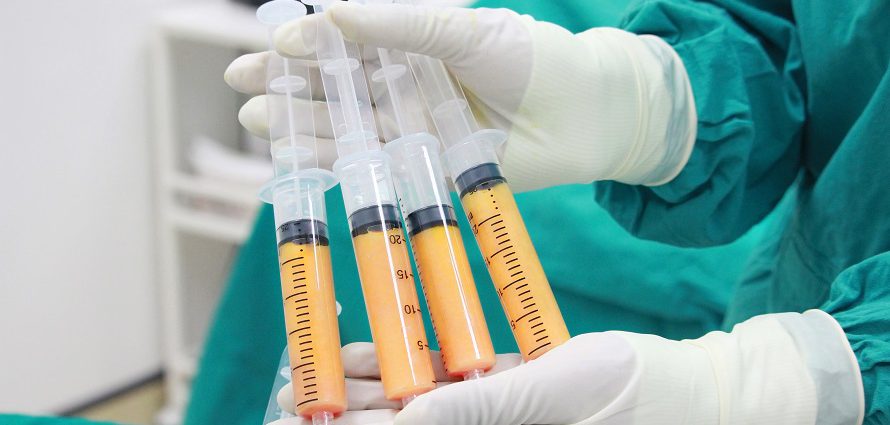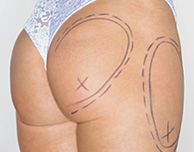Body Fat Transfers

Reviewed by Michael Olding, MD, FACS
In this article you’ll find information on several fat transfer topics:
- Is a body fat transfer right for me?
- The fat transfer procedure
- After fat transfer surgery
- Complications and risks of body fat transfer
- Body fat transfer costs
Fat transfers have been used for more than 100 years to fill in facial flaws such as hollowed cheeks, sunken eyes or indented scars, but what is old is new again. Today, new fat transfer techniques (also known as fat grafting) are used to augment many other areas of the body, including the buttocks, biceps, triceps, calf muscles, breasts, hands and penis. Many surgeons are also promoting stem cell face lifts, a fancy name for fat injections to the face.
Fat transfers have traditionally been used to surgically fill in and soften the edges of small, localized areas of the body. By comparison, body implants have traditionally been viewed as better for sculpting larger areas of the body. This perception is changing as plastic surgeons have begun to use larger-volume fat transfers, instead of artificial implants, to enhance the buttocks and other parts of the body. For more on these two different approaches and their applications, read our surgeon roundtable discussions of fat transfers and body implants.
A fat transfer involves your own fat cells, which means that it’s biocompatible and may help eliminate the risk of allergic reaction or rejection. Also, a body fat transfer feels and looks more natural than a body implant.
However, the results of this particular plastic surgery may be unpredictable. Much of the injected fat is absorbed, leaving an average of about 40 percent in place (although some surgeons claim a higher success rate).
Is Body Fat Transfer Right for Me?
Exercise and maintaining a normal weight are the best ways to improve your appearance, but aging and genetics may, over time, negate the positive effects of healthy living. For example, genetics may cause fat to be unevenly distributed. And, beginning in their mid-30s, people tend to start losing volume in specific body areas, including the face and hands. In these scenarios, fat transfers may help.
Body fat transfer candidates should be in good overall health, both physically and emotionally, and have realistic expectations about what the procedure can and can’t do for them. If you are a smoker, you should stop for several weeks prior to and following your procedure as smoking can slow the healing process, increase your risk of complications and impact negatively on your final cosmetic result. You must also have adequate fat deposits for the graft. Discuss the specific fat transfer procedure that interests you — including its pros and cons — with a board certified plastic surgeon. You can get started here.
The Fat Transfer Procedure
Body fat transfers are performed by a board-certified plastic surgeon in his or her office, outpatient center or hospital. The procedure may take up to two hours and is often performed under “twilight sedation,” which combines a number of medications that leave you sleepy and numb but awake. The procedure may also require general anesthesia, especially if it is being combined with other cosmetic surgeries.
The fat transfer procedure varies depending upon the technique used by the doctor and the area to be treated. The procedure can be described in three steps:
- Antiseptic and a topical anesthetic are applied to two areas: the location where the fat will be removed (donor site) and the treated area where the fat will be injected. The donor site is typically the abdomen or thighs.
- The fat cells are harvested from the donor site through one of several types of liposuction.
- The fat cells are processed and purified by the doctor before they are injected into the treated area. In some cases, the doctor will use a technique that spins the fat cells before they are injected beneath the skin. Other doctors strain the fat cells instead of spinning them.
There are new devices that both purify and concentrate the fat for direct injection, without needing a separate step. Cytori’s Puregraft is an example of such technology.
It takes three to four days for the first tiny blood vessels (capillaries) to reach and supply the newly-transplanted fat cells with a blood supply. During this time, up to 60 percent of the transferred fat cells will die. For this reason, doctors will usually overfill the treated area. More than one treatment may be required to achieve the best results. Each time the procedure is repeated, more fat accumulates in the treated area. This tends to offer longer-lasting — even lifetime — results.
Fat Transfer Recovery
After the procedure, you will need someone to drive you home. You may also need someone to help you with daily activities during your recovery from fat transfer surgery. Your doctor should provide you with specific post-op instructions including taking it easy for up to three weeks after the procedure. Within two to three days after the procedure, your doctor will remove your bandages and you will be able to shower again.
The treated area may be red for the first 48 hours following your fat transfer. There is typically some swelling for several weeks; however, any bruising should subside within a few days. Scabs may also form at the injection site. Oral pain medications can help treat any discomfort. Your doctor will give you a prescription or discuss appropriate over-the-counter medications with you. Some OTC products, including non-steroidal anti-inflammatory drugs (NSAIDs) such as ibuprofen and naproxen, may increase your risk of bleeding and should not be used unless your doctor advises otherwise. You should notice a marked improvement in your appearance after the procedure, although final results may not be evident for several months or more.
Complications and Risks of Body Fat Transfer
Complications are possible with any medical procedure, but complications from fat transfers are rare. The most common include bruising, swelling, redness, fatty bumps beneath the skin, uneven skin texture, infection, an abscess, excessive bleeding, and scarring. If fat is injected into two or more areas, asymmetry may occur.
Treatment for complications can range from oral medications to surgery. You can reduce your overall risk of body fat transfer complications by following your doctor’s instructions before and after the procedure.
Choosing a board-certified plastic surgeon from the American Board of Plastic Surgery will go a long way toward maximizing your satisfaction with the cosmetic results of the fat transfer and protecting your health. Board certification requires specific and rigorous surgical education and training on the part of the surgeon. Choose a surgeon who has extensive, specific experience in all types of body fat transfer procedures, including the procedure that you are interested in.
Body Fat Transfer Cost
The fat transfer procedure includes three costs: the surgeon’s fee, anesthesia fee and facility fee. Factors that figure into the overall cost include the surgeon’s skill and training, the geographic location where you are having your surgery, and the technique used.
It is difficult to establish an average cost for the fat transfer procedure because every case is unique. Since body fat transfers may be performed during other procedures, anesthesia and facility fees may be combined with those procedures. The total fees for fat transfers can range upwards from $3,000, depending on how many areas are treated and how much fat is harvested and injected. Be sure to get a comprehensive quote from your plastic surgeon before scheduling your fat transfer surgery.
The cost of body fat transfer is rarely covered by medical insurance because it is generally considered to be a cosmetic procedure. When fat transfer surgery is performed after a traumatic injury, some or all costs may be covered by your insurer. If the cost of the fat transfer surgery is difficult for you, ask your surgeon about payment plans.
About the Reviewer of This Article
Michael Olding, MD, FACS, of Washington, D.C. is board-certified in plastic and reconstructive surgery by the American Board of Plastic Surgery and is a member of the American Society of Plastic Surgeons, the Northeastern Society of Plastic Surgery and the National Capital Society of Plastic Surgeons, where he was elected president. Dr. Olding specializes in cosmetic plastic surgery procedures and clinically related activities in cosmetic surgery, cosmetic facial surgery, breast augmentation and reduction, rhinoplasty, body contouring, liposuction and melanoma. He is also one of the area experts on soft-tissue fillers (Restylane, Sculptra and Botox). He received his doctorate in medicine from the University of Kentucky in 1980 and completed his internship at Cornell Medical Center. He completed his fellowship in plastic and reconstructive surgery at McGill University in Montreal. Dr. Olding maintains hospital staff privileges at George Washington University Medical Center, Sibley Hospital and Children’s Hospital in Washington, D.C. More about Dr. Michael Olding



